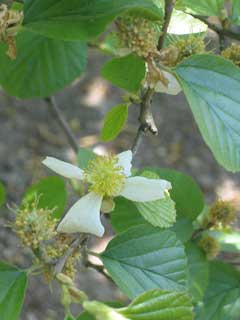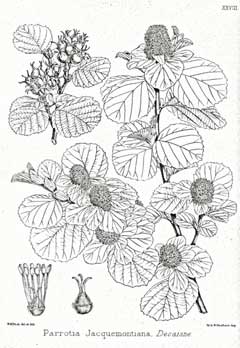 |
|
www.flickr.com/photos/dusanima |
 |
| http://commons.wikimedia.org/wiki/File:Parrotia_jacquemontiana_Bra28.png |
Translate this page:
Summary
Physical Characteristics

 Parrotiopsis jacquemontiana is a deciduous Shrub growing to 6 m (19ft) by 4 m (13ft).
Parrotiopsis jacquemontiana is a deciduous Shrub growing to 6 m (19ft) by 4 m (13ft).
See above for USDA hardiness. It is hardy to UK zone 7 and is not frost tender. It is in flower from April to June. The species is hermaphrodite (has both male and female organs).
Suitable for: light (sandy), medium (loamy) and heavy (clay) soils. Suitable pH: mildly acid, neutral and basic (mildly alkaline) soils. It can grow in semi-shade (light woodland) or no shade. It prefers moist soil.
UK Hardiness Map
US Hardiness Map
Synonyms
P. involucrata. Fothergilla involucrata. Parrotia jacquemontiana.
Plant Habitats
Woodland Garden Sunny Edge; Dappled Shade; Shady Edge;
Edible Uses
References More on Edible Uses
Medicinal Uses
Plants For A Future can not take any responsibility for any adverse effects from the use of plants. Always seek advice from a professional before using a plant medicinally.
None known
References More on Medicinal Uses
The Bookshop: Edible Plant Books
Our Latest books on Perennial Plants For Food Forests and Permaculture Gardens in paperback or digital formats.

Edible Tropical Plants
Food Forest Plants for Hotter Conditions: 250+ Plants For Tropical Food Forests & Permaculture Gardens.
More

Edible Temperate Plants
Plants for Your Food Forest: 500 Plants for Temperate Food Forests & Permaculture Gardens.
More

More Books
PFAF have eight books available in paperback and digital formats. Browse the shop for more information.
Shop Now
Other Uses
Basketry Wood
The branches are very strong and flexible. They are used in basket making and can also be twisted together into thick ropes for making bridges[11, 146, 160]. Wood - hard, heavy, very close grained. Used for walking sticks, tent pegs, axe handles etc[11, 145, 146].
Special Uses
References More on Other Uses
Cultivation details
An easily grown plant, succeeding in almost any soil, including limey ones[182], in sun or part shade[200], but it is liable to damage from late frosts[184]. Prefers a good deep fertile loam[200]. Prefers acid soils but it shows a good tolerance of alkaline and chalky soils[200], except very shallow soils over chalk[188]. The dormant plant is hardy to about -20°c[184].
References Carbon Farming Information and Carbon Sequestration Information
Temperature Converter
Type a value in the Celsius field to convert the value to Fahrenheit:
Fahrenheit:
The PFAF Bookshop
Plants For A Future have a number of books available in paperback and digital form. Book titles include Edible Plants, Edible Perennials, Edible Trees,Edible Shrubs, Woodland Gardening, and Temperate Food Forest Plants. Our new book is Food Forest Plants For Hotter Conditions (Tropical and Sub-Tropical).
Shop Now
Plant Propagation
Seed - best sown as soon as it is ripe in the autumn. It can take 18 months to germinate[200]. Sow stored seed as soon as it is received in a cold frame. When they are large enough to handle, prick the seedlings out into individual pots and grow them on in the greenhouse for their first winter. Plant them out into their permanent positions in late spring or early summer, after the last expected frosts. Cuttings of half-ripe wood, July/August in a frame[200]. Layering in April. Takes 12 months[78]. Very high percentage.
Other Names
If available other names are mentioned here
Native Range
TEMPERATE ASIA: Afghanistan (east) TROPICAL ASIA: India (Himachal Pradesh, Jammu and Kashmir), Pakistan (north)
Weed Potential
Right plant wrong place. We are currently updating this section.
Please note that a plant may be invasive in one area but may not in your area so it's worth checking.
Conservation Status
IUCN Red List of Threatened Plants Status :

Growth: S = slow M = medium F = fast. Soil: L = light (sandy) M = medium H = heavy (clay). pH: A = acid N = neutral B = basic (alkaline). Shade: F = full shade S = semi-shade N = no shade. Moisture: D = dry M = Moist We = wet Wa = water.
Now available:
Food Forest Plants for Mediterranean Conditions
350+ Perennial Plants For Mediterranean and Drier Food Forests and Permaculture Gardens.
[Paperback and eBook]
This is the third in Plants For A Future's series of plant guides for food forests tailored to
specific climate zones. Following volumes on temperate and tropical ecosystems, this book focuses
on species suited to Mediterranean conditions—regions with hot, dry summers and cool, wet winters,
often facing the added challenge of climate change.
Read More
Expert comment
Author
(Decne.)Rehder.
Botanical References
11200
Links / References
For a list of references used on this page please go here
Readers comment
© 2010, Plants For A Future. Plants For A Future is a charitable company limited by guarantee, registered in England and Wales. Charity No. 1057719, Company No. 3204567.